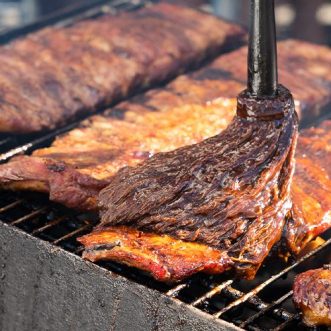The Mississippi River runs between Minneapolis and St. Paul.
Image: Shutterstock
Unofficial, highly opinionated information about Minneapolis and St. Paul
…
The Mini Apple or the Saintly City — which to choose? (St. Paul’s original name was actually “Pig’s Eye” — monikers have vastly improved.) Minneapolis is a little edgier: This is the heart of the Cities’ music scene, where Prince performed legendary shows at First Avenue, and where Lizzo had her come up. There are stars of equal measure in Minneapolis’s restaurant world: Chef Sean Sherman recently earned two James Beard nominations for his full-service Indigenous restaurant Owamni, which serves a decolonized menu (think venison tartare and seaweed sorbet instead of beef, milk, flour, and white sugar) near St. Anthony Falls on the Mississippi River — or, in the Dakota language, Owámniyomni, which means whirlpool or eddy.
…
East Lake Street offers an array of Mexican restaurants and panaderias, plus two beloved indoor markets: Mercado Central and Midtown Global Market. Lake Street, of course, became the center of the social uprisings of 2020, which began in Minneapolis and sparked nationwide protests for racial justice after the murder of George Floyd. That summer, people at all levels of the restaurant industry helped assemble a vast network of mutual aid and community protection — but at the same time, many family- and immigrant-owned restaurants were damaged in the fires. These businesses continue to recover — and while municipal reform stalls, many chefs, entrepreneurs, and service workers are among the leading voices still calling for change.
…
…
Hottest Restaurants: Among the Twin Cities’ hottest new restaurants are Khâluna — chef Ann Ahmed’s homage to Laotian and South East Asian cooking in an airy, beach resort-influenced space on Lyndale Avenue — and Ama Sushi, a Tibetan and Japanese sushi-and-momos restaurant. Iconos Gastro Cantina is a mod Latin American spot serving a double-cut Chamoy-glazed chuleta and “El Cantarito”: a whole bottle of tequila blanco served with grapefruit in a clay bowl. Supper clubs, also, are having a moment in the Twin Cities: Choose between crawfish gratin and andouille mussels at Mr. Paul’s Supper Club in Edina, or brandy Old Fashioneds and relish trays at the Creekside Supper Club, a veritable love letter to the wood-paneled, crimson-carpeted supper clubs of northwoods Wisconsin. Or go for Hmong homestyle cooking — like “zoo siab,” or “happy meals,” made with barbecue pork, Hmong sausage, or Hilltribe chicken — at Union Hmong Kitchen, by James Beard finalist chef Yia Vang.
:no_upscale()/cdn.vox-cdn.com/uploads/chorus_asset/file/23376726/Layer_7.png)
…
Essential Restaurants: The Twin Cities’ essentials list includes 38 restaurants throughout Minneapolis and St. Paul — but if you have to narrow it down, start with a steaming bowl of pho or a banh mi at Quang Restaurant on Nicollet Avenue, a cornerstone of Minneapolis’s Eat Street. Or, build your own meal at Soul Bowl, a popular soul food pop-up-turned-restaurant now in Graze food hall in the North Loop. For dinner, make a reservation (well in advance) for Owamni, a full-service Indigenous restaurant by James Beard-nominated chef Sean Sherman, where the decolonized menu favors venison tartare, salmon roe, and walnut ice cream over beef and pork, flour, dairy, and white sugar. Try the tortillas at Nixta Tortilleria and Sooki & Mimi, where chefs Gustavo Romero and Ann Kim, respectively, use heirloom corn varieties to create thoughtful bases for migas tacos and mushroom birria. For stellar tasting menus, make a reservation at Travail Kitchen and Amusements, or Demi, a fine dining restaurant by lauded chef Gavin Kaysen.
:no_upscale()/cdn.vox-cdn.com/uploads/chorus_asset/file/23376722/210713_OwamniSoftOpen_Sean_018.jpg)
…
Iconic Dive Bars: Northeast Minneapolis, one of the Twin Cities’ historic industrial centers, is a tapestry of great dive bars. Wear that old flannel with the elbows patched up — likely nowhere else in the U.S. will you meet a bar-going crowd so determinedly casual. Moose Bar & Grill is a neon-lit spot on Monroe Street with artichoke-and-bacon-stuffed potato skins; besides that, go for the meat raffles, bingo, and pull tabs. Grumpy’s has an old-fashioned jukebox and a range of draft pours, and is a favorite haunt of local musicians. The Terminal hosts weekly comedy nights on Thursdays, and Vegas Lounge — which, upping the ante for all local dives, has wood paneling on the ceiling — does karaoke seven nights a week. Over in St. Paul, the West Seventh neighborhood is another great spot for dive bars. Try the pizza and $3 rail drinks at Skinner’s happy hour, or go for White Castle brunch and cribbage at the Spot Bar.
Cocktails: Maybe an IPA garnished with a pickle spear isn’t your thing. Turn the page from the Twin Cities’ dive bars to the cocktail scene, which has no shortage of ambrosian pours. Sooki & Mimi’s bar serves excellent tepache — a fermented pineapple drink made on site — with mezcal, tequila, or vodka. (Or look for the light in the 31st Street alleyway and take the stairs down to one of the Cities’ classiest speakeasies, designed like a ’70s rec room.) Brother Justus Whiskey Company serves a whiskey made with black spruce peat from Aitkin County, Minnesota, and Estelle’s long-and-narrow bar, adjacent to the dining room, is a great spot for a romantic date night. Downtown Minneapolis has more than a few cocktail bars to offer: Spoon and Stable has recently reopened with fresh, inventive drinks (think a gin and tonic with kumquat and winter citrus). P.S. Steak near Loring Park has two notable bars to choose from: a marble walk-up bar in the lounge, and another in the Victorian dining room, which requires a reservation.
:no_upscale()/cdn.vox-cdn.com/uploads/chorus_asset/file/22291897/Sooki_and_Mimi_Bar_and_room_cr_Jes_Lahay.jpg)
…
Burgers: The Juicy Lucy — a hefty beef patty stuffed with molten cheese, served with all variety of buns and toppings — is perhaps the Twin Cities’ most iconic dish. The burger originated at Matt’s Bar (a legendary Cedar Avenue dive) in 1954, when — as legend has it — a customer requested two hamburger patties with a slice of cheese between them. Matt’s calls its burger the “Jucy Lucy,” with no “i”: Hot takes like the Groveland Tap’s Cajun Lucy and Blue Door Pub’s blue cheese “Blucy” have since proliferated. The Cities also have a wealth of plain old burgers: Try the thin and cheesy diner-style burger at Parlour, thick patties on brioche at Lowry Hill Meats, or Le Petite Cheeseburger, topped with caramelized onions and pickled cucumbers, from Petite León.
Pho: After the end of the Vietnam War, thousands of Vietnamese refugees resettled in Minnesota. As a result, the Twin Cities are home to many Vietnamese restaurants, and thus, an abundance of brothy, fragrant bowls of pho. There are two main hot spots for pho in the Cities: Eat Street on Nicollet Avenue in Minneapolis, and Little Mekong, or Frogtown, on University Avenue in St. Paul. Minneapolis’s Quang serves a classic, balanced pho tai, and Lotus Restaurant serves a variation it calls “pho stew,” made with potatoes and carrots. Over in St. Paul, iPho by Saigon offers massive portions laced with spices like cloves and star anise, and Pho Ca Dao is a cash-only restaurant that serves just two things, pho and egg rolls — with culantro, a more pungent cousin of cilantro, in its bowls.
…
Hmong cuisine: The Twin Cities is home to a thriving Hmong community. Between 1961 and 1973, overlapping the Vietnam War years, the Hmong — a nomadic people who lived in the mountainous regions of northern Laos, Thailand, Burma (present-day Myanmar), Cambodia, China, and Vietnam — were recruited as part of a covert, anti-communist CIA operation, now known as the Secret War in Laos. After the war ended, Hmong soldiers and their families who had aided the CIA were persecuted by the victorious Pathet Lao — many, after escaping across the Mekong River to Thai refugee camps, eventually resettled in Minnesota. Now, the Twin Cities is a vibrant center of Hmong cuisine — visit Hmongtown Village Shopping Center in St. Paul for papaya salad, koj thiab ntiv (Hmong chicken with herbs), and crazy steak with wasabi sauce and pepper paste from Santi’s.
Local chef Yia Vang, whose restaurant Union Hmong Kitchen is a heartfelt homage to Hmong home cooking, was recently named a finalist for the James Beard award for best chef, Midwest. Head over to Graze food hall in the North Loop to try his Hmong sausage patties, barbecue pork, and Hilltribe grilled chicken. Vang’s much-anticipated restaurant Vinai is slated to open in 2022.
…
Brunch: Grab a Southern-style brunch (a rare find in the Twin Cities) of ham-brined chop or rock shrimp and grits at chef Justin Sutherland’s Handsome Hog in St. Paul. In Minneapolis, the Lynhall serves massive croissants stuffed with pistachio and lavender pastry cream in its elegant dining hall space, and Victor’s 1959 Cafe is a go-to for Cuban fare, like slow-cooked ropa vieja with eggs and plantains. (Pick up a cafe con leche with house-made sugar paste from the window.) In Northeast, enjoy biscuits from Betty and Earl’s at a rollicking weekend drag brunch inside Lush, which has recently returned to the Cities’ brunch scene.
:no_upscale()/cdn.vox-cdn.com/uploads/chorus_asset/file/23376792/HK_6568.jpg)
…
Coffee shops: Nearly every neighborhood in the Twin Cities has an excellent coffee spot. Try the Turkish coffee (and tahini babka) from pastry chef Shawn McKenzie at Café Cerés in Linden Hills, or a cup made with coriander bitters and Hawaiian sea salt at Five Watt Coffee on Nicollet Avenue. Grab a sweet potato latte from Black-owned, Black-led spot The Get Down Coffee Co. in the Camden neighborhood. In St. Paul, cozy up in Claddagh Coffee’s red-brick coffee bar, or grab a to-go cup from Nina’s Coffee Cafe and wander the streets of the historic Cathedral Hill neighborhood.
…
Ice cream: Even in a minus-17-degree windchill, ice cream is a year-round affair in the Twin Cities. Sebastian Joe’s is perhaps the most quintessential Minnesota shop — its Nicollet Avenue Pothole flavor, a chocolate-and-caramel homage to the freeze-thaw cycles of the Midwest — is a favorite. Bebe Zito is the most exciting newcomer on the ice cream scene: it’s known for gutsy add-ins like caramelized Fruity Pebbles, Vietnamese coffee, and wedding cake. Milkjam’s vegan chocolate is richer than the deepest, black-gold layers of the earth’s crust, and Grand Ole Creamery serves waffle cones at a whiplash rate on summer nights. Conny’s Creamy Cone is an excellent spot for chili dogs and soft serve nostalgia.
:no_upscale()/cdn.vox-cdn.com/uploads/chorus_asset/file/22503839/bebe.jpeg)
…
Pizza: Try the so-weird-it’s-good Rueben pizza at Skinner’s Pub in St. Paul’s West Seventh neighborhood. Pizza Luce has plenty of vegan and gluten-free options at locations all around the metro, and Wrecktangle serves rectangular, steel pan-baked Detroit-style pizza at Graze hall in the North Loop (a Lyn-Lake location is forthcoming). Young Joni is perhaps the North Star of the Twin Cities’ pizza scene: Favorites on James Beard-winner Ann Kim’s menu are the Umami Mama with cremini, shiitake, and portobello mushrooms, and La Pariesienne, with prosciutto and brown butter. Slip into the speakeasy — all midnight florals and green velvet — through the back alley.
…
Beer: Taprooms in the Twin Cities abound. Check out these essential spots: Bauhaus Brew Labs, which serves balanced IPAs and German-style lagers; Modist, which claims 18,000 square feet in the North Loop; and Fair State Brewing in Northeast, Minnesota’s first brewing cooperative. Dangerous Man Brewing Company serves rich brews like a mint chocolate moose double stout and a peanut butter porter. Lift Bridge Brewing Company out in Stillwater — a historic logging town on the St. Croix River — is a great stop for a day trip away from the metro. Sociable Ciderwerks is a popular option for house-brewed ciders — in the winter, they bring in hoses and boards and fashion a skating rink out of their parking lot.
Twin Cities Food Neighborhoods to Know
Eat Street: On the north end of Nicollet Avenue, Eat Street is one of Minneapolis’s culinary hot spots. Pimento Kitchen and Rum Bar has some of the Cities’ best Jamaican food: Get a bowl with braised oxtail and plantains or go for the curried veggies — either way, add at least two of the house-made sauces. Lu’s Sandwiches has infamous banh mi, and Quang serves a fragrant, balanced bowl of pho — both are family-owned local legends. Marhaba Grill has a bountiful Mediterranean buffet, with plenty of desserts like baklava and basbousa, and Icehouse — one of the Twin Cities’ most popular music venues — makes great cocktails.
…
East Lake Street: Running through the heart of Minneapolis’s Phillips, Powderhorn, and Longfellow neighborhoods, East Lake street is home to a wealth of Mexican restaurants and panaderias. Mercado Central is a great place to start: Explore this indoor market of 35 businesses and indulge in fresh-made tacos, tamales, empanadas, and aguas frescas (or an orange and beet smoothie at La Reyna de los Jugos). Tortilleria La Perla, which sells wholesale to businesses across the state, has a restaurant here. Stop into a panaderia for a snack after lunch: conchas or orejas from El Mexicano. Further east, grab crispy birria tacos at Taqueria Las Cuatro Milpas — or get a margarita made with lavender syrup and creme de violette at Sonora Grill and then head next door to El Norteño, an excellent women-owned restaurant. Central Lake Street is also home to Midtown Global Market, which has a dazzling array of local restaurants.
Uptown: Minneapolis’s Uptown and Lyn-Lake neighborhoods maintain a slightly tattered, scrappy cool. The intersection of Lyndale Avenue and Lake Street is a public transportation-friendly part of town that’s packed with restaurants. Check out LynLake Brewery for beer, rooftop views, and “Oakie Style” double-patty onion burgers. World Street Kitchen is one of the Twin Cities’ greatest food truck-to-restaurant success stories: Go for the Hanoi fish yum yum bowl, and stay for dessert (Milkjam Creamery is just next door). Nearby Nightingale has extensive wine, beer, and cocktail offerings. Off Hennepin Avenue, don’t miss Sooki & Mimi by chef Ann Kim — if you can’t get a reservation for the prix fixe menu, order heirloom corn tacos from the bar, or slip into the basement speakeasy for a drink. Isles Bun and Coffee is known for its braids of cinnamon brioche topped with cream cheese frosting, aka “puppy dog tails.” Grab some and wander down to the 32nd Street beach at Bde Maka Ska to eat them by the water.
…
North Loop: Minneapolis’ popular North Loop neighborhood is home to a number of upscale dining destinations, like Gavin Kaysen’s Spoon and Stable (and now, also, Demi); Italian and Japanese fusion restaurant Sanjusan; and Bar La Grasa, which serves a mean lobster-and-scrambled eggs bruschetta. Other more casual gems abound — like Graze Provisions and Libations, home to Soul Bowl, B.A.D. Wingz, Union Hmong Kitchen, Wrecktangle, and more. Find some of the city’s best bagels at Rise, plus a selection of cream cheeses and spreads, from scallion and salted maple to strawberry preserves.
…
Kingfield/Fulton: Nicollet Avenue’s southern stretch is dotted with fantastic restaurants like Hola Arepa, one of the pioneers of the Twin Cities’ food truck community, which offers a cozy year-round patio for outdoor dining in all seasons. Petite León, the work of James Beard-nominated chef Jorge Guzmán, is an intimate neighborhood cafe with a Yucatán Peninsula-influenced menu, an exceptional burger, and creative, citrus-forward cocktails. Nighthawks has some magnificent takes on diner food and often hosts live music on their patio.
:no_upscale()/cdn.vox-cdn.com/uploads/chorus_asset/file/23376772/Petite_Leon_food_and_drinks_cr_Lucy_Hawthorne.jpg)
Lucy Hawthorne
…
Linden Hills: This quiet, residential pocket of Minneapolis is surprisingly restaurant-dense. It’s home to James Beard Award 2020 finalist Steven Brown’s Tilia, and two restaurants from chef Danny del Prado’s elegant trio: Rosalia, which serves wood-fired pizzas, and Martina, with more elevated dishes like bavette with potato churros and seared scallops. The Harriet Brasserie has a lovely patio where you can follow a glass of white wine with a slice of tres leches cake — or grab a smoked ham sandwich from Clancey’s and head to the Lake Harriet Bandshell for live music and a picnic on the weekend.
…
Northeast: “Nordeast,” as longtime residents might call it, is one of Minneapolis’s former industrial centers, historically a blue-collar area that’s home to many immigrant communities. Central Avenue is one of Minneapolis’s most vibrant food corridors: Get a $3 slice of pie at the Ideal Diner, a colossal burrito at El Taco Riendo, or a tender seco de pollo at Ecuadorian restaurant Chimborazo. Northeast has an array of more upscale restaurants: Hai Hai, by James Beard-nominated chef Christina Nguyen, and Young Joni, by James Beard-winner chef Ann Kim, are both favorites. Anchor Fish and Chips has arguably the best fish and chips in the Twin Cities, and Aster Cafe has jazz music and dancing on Sunday afternoons. There’s a whole barbecue scene in the area — check out Animales, Market BBQ, and newcomer Boomin Barbecue. Don’t miss the vibrant Mexican breakfast and lunch options at Vivir.
:no_upscale()/cdn.vox-cdn.com/uploads/chorus_asset/file/11739243/HAI_HAI___Patio____Photo_by_Kevin_Kramer_10.jpg)
…
Lowertown: Long a hub for artists of the Midwest — and home to a new minor league baseball stadium for the St. Paul Saints — Lowertown is also a hot spot for restaurants in St. Paul. Grab some of the Cities’ best southern fare at chef Justin Sutherland’s Handsome Hog, which makes for an excellent brunch of brisket hash or shrimp po’ boys. Saint Dinette has one of the Cities’ most revered burgers: two chunky patties with American cheese and a side of delicate pickle slices. Drink cocktails and play arcade games at Oxcart Arcade and Rooftop, or sample a flight of local beers at the Bulldog.
…
Cathedral Hill: St. Paul’s Cathedral Hill neighborhood is in the shadow of the city’s Roman Catholic cathedral. The area is filled with charming, historic red-brick buildings and stately homes — its main food corridor runs along Selby Avenue. Revival is a popular spot for fried chicken — or swing in a hammock on the breezy patio at the Gnome Craft Pub. Wee Claddagh is a charming spot for coffee, and J. Selby’s serves creative vegan takes on fast food, like dairy-free shakes and crunch wraps filled with a taco-seasoned Beyond blend, peppers, and onions. W.A. Frost has a lovely patio, and serves classic entrees like braised pork shoulder and New York strip.
…
West Seventh: Extending out of downtown St. Paul, the West Seventh area has long been known for neighborhood bars and restaurants. In recent years, new shops, restaurants, and craft breweries have opened alongside some of these classic spots — but the dive bars, those old stalwarts, remain. Brake Bread and Mojo Monkey Doughnuts serve early-morning treats, and Café Astoria is a go-to for coffee in a cozy room. West Seventh is also home to Keg and Case, a market and food hall with many options, from mac and cheese to Jamaican fare.
…
Frogtown: With a marvelous array of restaurants along University Avenue, Frogtown is also known as Little Mekong — thus named for the thriving Southeast Asian communities that call it home. The Green Line light rail runs down University Avenue, making this a super-accessible spot for a meal. Bangkok Thai Deli and Supermarket serves a gigantic bowl of pork boat noodles, and Cheng Heng is known for its red curry tom yum soup, chive cakes, and red bean rice donuts. Trung Nam French Bakery serves equally good banh mi and croissants, and Hoa Bien has creative takes on desserts, like a banh flan with Vietnamese coffee.
…
…
ICYMI
Construction On New Bde Maka Ska Concessions Pavilion Area Begins – Minneapolis, MN


:no_upscale()/cdn.vox-cdn.com/uploads/chorus_asset/file/15959589/20190307_Quang_080.jpg)





